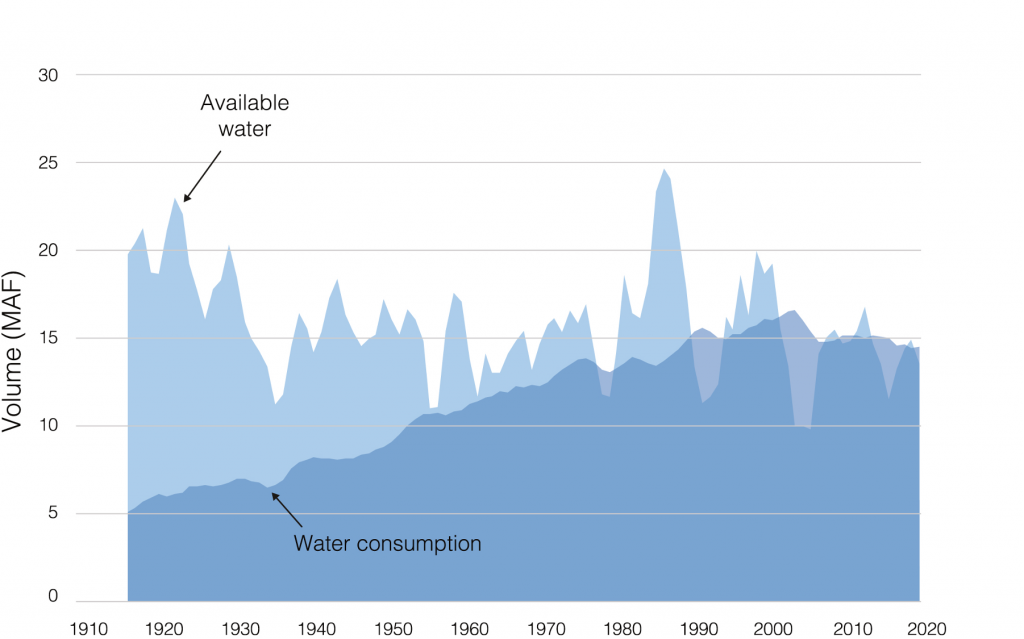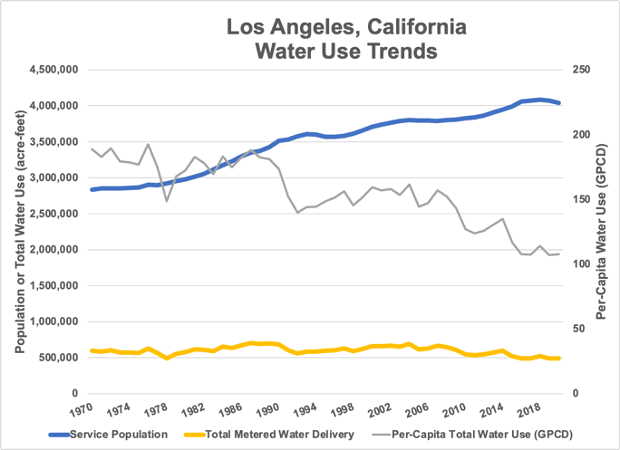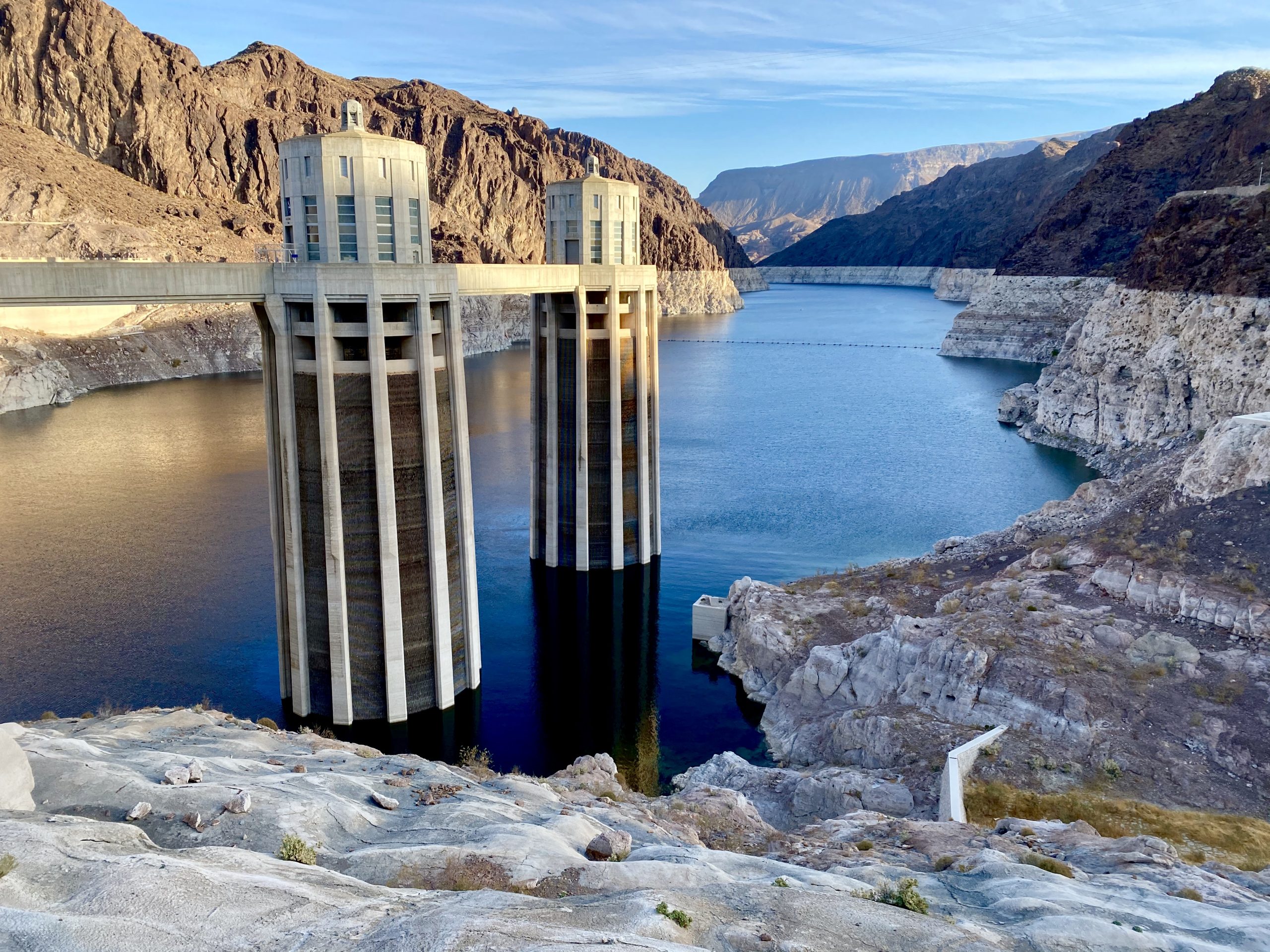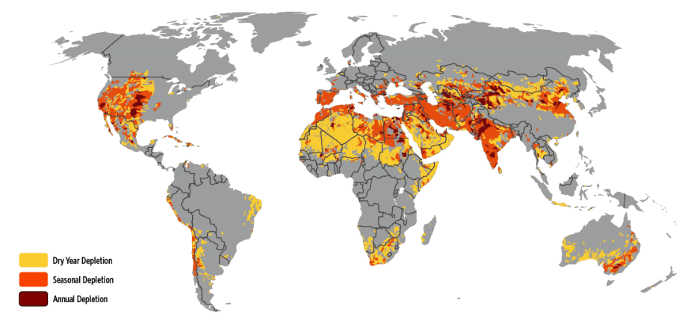Hey Reporters: Let’s Get This Story Straight
Lake Mead on the Colorado River is now nearly two-thirds empty. Photo by Brian Richter
______________________________________________________
Seems like every day brings another news story about the water crisis in the Western US.
Never in my lifetime have I seen such an intense drought spanning such a wide geographic sweep: from West Texas to the Rio Grande to the Colorado River to the Central Valley of California to the Klamath River in Oregon.
It’s really important for this story to get a lot of media attention, because publicity can help provoke the big changes that desperately need to happen with water management in the West. But it’s also critically important that reporters get this story straight, so that their readers will understand how we got into this mess, and how we can move toward a more secure and sustainable water future.
Here’s a few key points, addressing some of the most common misconceptions about water scarcity.
#1. Droughts Don’t Cause Water Scarcity. People Do.
By definition, water scarcity is human-driven; it is a function of the volume of water consumed by humans relative to the volume of accessible, affordable water resources in a given area. As such, an arid region with very little water but no human water consumption would not be considered “water scarce,” but rather simply “arid.” Similarly, droughts do not in themselves cause scarcity; instead, scarcity and associated water shortages occur when human demands for water are greater than what is available at any given time. Simple supply and demand logic.
Your bank account is a very good analog. If you are always spending virtually all of the money you deposit, you are highly vulnerable to overdraft when (1) you aren’t depositing as much money, such as when you experience an interruption of your income; or (2) you have a need to spend more, such as to pay a hefty doctor’s bill. If you don’t have enough money in your savings account to cover your overdraft, you go bankrupt (or at least bounce a few checks).
Therefore, focusing only on the supply (deposit) side — the lessened availability of water during a drought — is only half the scarcity story. It’s very important to tell the other half, which is that our consumption (spending) has become too high relative to water availability.
From my analyses of the emergence of scarcity in many places around the globe, it’s quite obvious that a community’s vulnerability to water shortages increases greatly as human dependence on a particular water supply such as the Colorado River is allowed to grow to the limits of the natural, renewable water supply. A city or farming district might get by pretty well during normal or wet years, but when drier times eventually come, somebody doesn’t get the water they need and water-dependent ecosystems suffer.
The graph below illustrates this very well, and the map below shows the places in the world where water consumption has been approaching the limits of water supplies.

Virtually all of the water flowing in the Colorado River was being consumed during the mid-1950s drought, yet consumption was allowed to increase, largely without constraint. Consumption now exceeds annual river flows in most years; the overdraft is accommodated by pulling water out of storage reservoirs such as Lake Mead. Those reservoirs are being rapidly depleted, placing the communities and businesses dependent upon the river at great risk of water shortages. (Data source: US Bureau of Reclamation. MAF=million acre feet)
This map highlights the places around the globe that are experiencing water shortages. Yellow areas on the map represent places that experience water shortages during droughts, orange areas experience scarcity during certain months of the year, and red areas are chronically short of water. Water scarcity presently affects half of the world’s population and three-fourths of all irrigated agriculture. (Map and statistics from Brauman and others, 2016)
#2. Don’t Blame This on the Cities
Tim Egan of the New York Times, when writing about the Colorado River last month, got it right: “….Vegas, and other oasis metropolises like Los Angeles, Phoenix and Tucson, are not the problem.”
He’s right for two important reasons: (1) urban water uses — including residential, commercial, and industrial uses — account for only 11% of all water consumption in the West; and (2) urban water use has been declining since the 1980s.
There are many examples of water-guzzling urban areas, particularly smaller towns and ‘exurbs’ of large metropolitan areas, but in general the big cities of the West have been doing a phenomenal job of actually lowering their water use even while their populations have grown rapidly. Our research, published last year in the international Water journal, documented that on average, Western US cities have grown by 21% while their water use has decreased by 19% during the past two decades.
Los Angeles is a terrific example of a high-performing water conservation city, as shown in the graph below.

Over the past 50 years, the City of Los Angeles has been able to reduce its total water use by 23% even while its population grew by 43%. The City was able to accomplish this largely by incentivizing its residents to reduce their per-capita water use by more than 40%. (Data and statistics from Richter and others, 2020)
#3. Water Scarcity Isn’t a New Story
Some communities in the Western US have been struggling with water scarcity — and experiencing water shortages — for more than 100 years. We developed the animation below (click to activate) to illustrate the fact that many areas around the world, including much of the Western US, have been bumping up against the limits of their natural renewable water supplies for a very long time. This animation highlights places where total water consumption nearly equaled (or exceeded) water availability in each year.
Special thanks to Charles Wight of The Nature Conservancy for assisting with this animation.
This animation and the scarcity hot spots highlighted here are based solely on agricultural water consumption — it does not include any additional water consumed by cities or industries. Irrigated agriculture has always accounted for the lion’s share of water consumption in the West; even today it accounts for 86% of all water consumed. Many Western rivers were being heavily diverted for irrigation by the latter half of the 19th century, when farmers needed to feed massive waves of new settlers rushing to gold fields in California, Montana, and the Black Hills of South Dakota, and federal Homestead Acts gave free land to those willing to farm it.
Yes, farming is a very water intensive industry but it would not be appropriate to blame farmers for our water scarcity either. It simply takes a lot of water to produce food for our families, our country, and people around the world.
There are certainly too many farmers that use water wastefully, but the same can be said for city-dwellers. If there’s anyone to blame here, it should be directed at those that were entrusted to manage water on our behalf.
#4. Water Scarcity is a Failure of Governance
Elinor Ostrom won the Nobel Prize in Economic Sciences in 2009 in large part for her insightful work on “Governing the Commons.” Ostrom resisted the premise that shared (‘common pool’) resources would always fall victim to the tragedy of the commons, i.e., become over-exploited. Ostrom highlighted examples of communities, such as the Philippine irrigation farmers known as zanjeras, that manage their shared resources in communal fashion, such as by allowing each farmer to take a proportional share of the available water each year.
When I was writing the governance chapters of my Chasing Water book in 2014, I looked very hard to find other examples of successful communal water governance. In my book I wrote about the acequia irrigation systems brought to Mexico and the American Southwest by the Spaniards. But there are preciously few other good examples, and none at the scale of a large river basin.
Instead, most state and federal governments have taken a regulatory approach to water governance, specifically the prior appropriation system managed by state governments in the Western US. Under this system, state governments hold the water in trust and issue rights to use water to individuals, companies, water utilities, electricity producers, irrigation districts, and other water users.
The fatal flaw in this approach was that states issued far more water rights than the water flowing in their rivers. California, for example, has issued five times more rights than the mean volume of river water available! And as I pointed out in the graph above of the Colorado River, state regulators continued issuing more and more water rights even after the river had been almost completely drained by the mid-1950s.
It is a treacherously difficult and politically contentious challenge to try to get the cows back in the barn after they’ve busted loose. It takes strong courage for a politician or water regulator to take back some of the water that people have become accustomed to, and are financially dependent upon.
But some hopeful signs of leadership are emerging. In 2014, California passed a Sustainable Groundwater Management Act that requires sufficient reduction in pumping to stabilize aquifer levels; SGMA could result in 20% of farmland being taken out of production unless farmers can find other ways to reduce their water use. In 2019, the ‘Lower Basin’ states of California, Nevada, and Arizona that share the Colorado River agreed to curtailments in water use by as much as 20% of their current use, as needed to stabilize Lake Mead.
#5. It’s Time to Start Talking About the Long Game for Water in the West
Taking bold political steps to set a limit, or a cap, on the volume of water that can be taken from any particular river or aquifer is a very important place to begin the journey toward a secure and sustainable water future.
However, it is a far more daunting challenge to figure out how to live within those limits.
It’s understandable why reporters are drawn toward sensational stories of pain and loss during a water crisis like the one the West is experiencing. But crisis brings extraordinary opportunities as well. Let’s not squander this opportunity to begin vigorously designing a more sustainable and secure water future. I hope that media reporters will increasingly feature stories about the ways that cities and farmers and industries are adapting to water scarcity and climate change in progressive ways, rebalancing their overdrawn water budgets. What are the innovative ideas and practices and changes that we need to implement to get us out of trouble?
Stay tuned. I intend to continue telling some of those stories myself.



So many great points Brian! I wonder if there’s more that can be done around incentivizing farmers to grow less water intensive crops – there are certainly too many fields being farmed for low-value, water-intensive yields. I know Colorado is doing a lot to simply take farmland out of production, with some push-back from farmers, but it seems the only choice in some especially fragile areas. It’s also good to remember our role as consumers on the crops that get sown.
Looking forward to the next installment.
Thanks Ashley, I’m glad that you found the post to be of interest. It has become absolutely clear that we aren’t going to be able to rebalance water budgets — and substantially reduce risks of water shortages — unless we can find ways to greatly reduce water consumption in irrigated agriculture. Even if cities cut their water use in half, it would not substantially reduce shortages risks in most Western US basins, simply because urban and industrial uses are only a minor fraction. I do think the states and the federal government need to provide financial incentives or other forms of support to aid farmers in transitioning to less water-intensive crops, and in some places, retiring farmland where it is of marginal importance to food supply or local economies, and where it can benefit recreational opportunities or expand habitat area or migration corridors for fish and wildlife. Such programs need to be done very carefully and strategically, but we will continue to be at severe risk of shortages if we don’t start moving in this direction.
Brian, The following article exposes the freshwater withdrawals and outlines the non-beneficial consumption and nonrecoverable return flows which should be addressed to improve water use efficiency and alleviate the risk of drought.
We have been able to demonstrate in agriculture the potential of reducing the water footprint from 30% – 50% in California, for fruits and nuts (perennials) by conserving groundwater, and leaving water to be conveyed to downstream users. This is a nature based solution, that does not require any additional infrastructure, no additional labour, less energy, reduces global warming caused by water vapour via solar radiation feedback and does not involve any fallowing, with a 50 year service life.
What is the value that you associate with this solution, when you can insure no biodiversity loss? Is there a willingness to finance such a game-changer that implies a drop it and forget it technology? The more people know about the solution the better chances we have of getting this solution in place to avoid major catastrophic consequences.
What about over pumping of water, for water companies like Nestle?
Nice article. It is eye opening to realize that farmers are taking the lion share of water! Perhaps there could be incentives for farmers to take less water or maybe turn to less water intensive crops. As Ashely says above, a lot of fields seem to contain low value crops for feeding livestock so maybe we could shy away from eating so much beef, poultry and pork. I wonder if that would have any effect? Whatever we do, we must do something.
The source of water is challenged by a few reasons.
1) Over population of refugees and illegal migration into the Southwest states. I question the massive building of new residences and only ask one question the local public works “Where are you going to get the water to supply all these massive developments?”
2) The local people are forced to restrict water usage, yet Raging Waters, Magic Mountain, Knox Berry Farm, and Disneyland, have very high-water usage for entertainment.
3) Over 100 water bottling companies are tapping into the water supplies to send to all parts of the World in California alone.
4) Lastly, many public servants are lobbied by wealthy persons who provided funding for their elections are allowing land and water grabs by their lobbyists. Bill Gates is an example of one who owns a great portion of the drought-stricken farmlands, which will lead to higher costs to food and water.
Why can’t grey water from showers and dishwashers be used for watering lawns and plants instead of being illegal in California? Soapy water does not hurt plants and even prevents some insect destruction.
Some interesting points; however, have you ever dug deeper and given any consideration to why agriculture is irrigating?
Agriculture utilizes irrigation water to produce food for an ever-increasing population of humans and our pets. That food has a significant amount of water in it (https://www.ncbi.nlm.nih.gov/pmc/articles/PMC2908954/table/T1/), as does the human body (https://www.usgs.gov/special-topics/water-science-school/science/water-you-water-and-human-body) as well as our pets’ bodies.
While not acknowledged by the general public, Agriculture has also become more efficient with its water utilization {https://www.usgs.gov/media/images/trends-total-water-withdrawals-water-use-category-1950-2015-1) out of necessity as farmers produce more food on an ever-dwindling land base with reduced total water allocation as farmland is converted to more housing, shopping malls and industrial uses.
While it is easy to point at Irrigation as the second largest annual withdrawal of water as a part of the problem, to truly deal with that problem you need to examine what can be done at the root of the problem. Your fist point does hit the nail right on the head – perhaps we need to stop increasing the human population in those regions of such acute water scarcity.
Hi Brian – i’m only just now reading your excellent article here from June 2021, and am wondering why toward the end of it you did not briefly discuss the results of what you and your team found and published in your April 2020 scientific article for Nature Sustainability: namely, the need to fallow fields currently dedicated to cattle-feed crops and, more generally, for the population to reduce unsustainable beef/dairy consumption (which is also the #1 source of global deforestation and #1 source of GHGs)?
I moved to this hell hole a few months ago. As you cross Az to Ca border you see the problem immediately. they are farming the desert. Giant aqueducts with water stolen from colorado river to grow RICE in the freakin’ desert. CA bass ackwards in so many ways…..
Some interesting points; however, have you ever dug deeper and given any consideration to why agriculture is irrigating?
Agriculture utilizes irrigation water to produce food for an ever-increasing population of humans and our pets. That food has a significant amount of water in it (https://www.ncbi.nlm.nih.gov/pmc/articles/PMC2908954/table/T1/), as does the human body (https://www.usgs.gov/special-topics/water-science-school/science/water-you-water-and-human-body) as well as our pets’ bodies.
While not acknowledged by the general public, Agriculture has also become more efficient with its water utilization over the last 40 years {https://www.usgs.gov/media/images/trends-total-water-withdrawals-water-use-category-1950-2015-1) out of necessity as farmers produce more food on an ever-dwindling land base with reduced total water allocation as farmland is converted to more housing, shopping malls and industrial uses. And still, everyone complains that the price of food is too high, but those same people don’t make the link between policies that would limit the ability to grow food and the affect that will have on the price of their food. Yes, a lot of water is used for irrigation, but that is because as a nation the US needs a lot of food, and there is large demand for some crops that happen to need more water than others.
While it is easy to point at Irrigation as the second largest annual withdrawal of water as a part of the problem, to truly deal with that problem you need to examine what can be done at the root of the problem. Your fist point does hit the nail right on the head – perhaps we need to stop increasing the human population in those regions of such acute water scarcity.
Brian, thank you for writing this article. It is a subject that is of high interest to me. I am very familiar with settlement of California, Arizona, New Mexico and Texas. We have relatives in all 4 states. My father’s family arrived in the Tucson area in the early 1780’s. My mother’s family arrived in Santa Fe in 1625. Both families were ranchers. I believe my ancestors taught the Native Americans how to raise cattle and now researching to confirm. I am also researching to confirm that both families donated money and cattle to aid the American Colonies in the Independence from England.
In 1967 I was studying engineering at Arizona State University and hired on with an architectural engineering company just as the population explosion happened in the Phoenix Metro Area. By 1975 1000 new residents arrived each day. Our office doubled in size and we were working overtime every week to keep up with the new shopping malls, apartment complexes, hospitals that the architects were throwing at us. Then something happened. I don’t know what. I was 25 and too busy working and spending the overtime money. The projects slowed. I noticed that period coincides with the dip in the Water Consumption.
Then I looked at the rest of the Consumption. 1920’s Phoenix was a vast “city” of orange groves. By 1945 the orange groves started to disappear as the land was taken over by housing. 1945 is the time period that I would guess air-conditioning spurred the population increase. That spurt seems to be reflected in Water Consumption. 1982 is when the Recession hit, 1990 is when the bank failures happened, 2007 came the Financial Crisis. All three are reflected on the Water Consumption. I doubt that would be so dramatically reflected if the vast majority of the consumption was farming. I know the same population growth deletion of farmland happened in Los Angeles, Albuquerque. Possibly it would be safe to say that across the Southwest farmland was being replaced by housing. I am not saying that you are wrong but if farmland consumes X-time more water than housing I would expect that the Water Consumption would not rise as steeply as farmland is being depleted. The dips in Consumption in relation to housing is suspect. I did electrical engineering and don’t have your expertise on this topic. I am not yet convinced farms are such a significant share of the problem.
What about the companies over pumping water? like nestle. Ive asked this before looks like my comment didnt get accepted.
Population growth is a culprit. Increase causes more demand.
Interesting report. I want to thank you for bringing awareness to the water shortages which are causing so many issues like endangered animal protection and energy for everyday life. I didn’t see anything about veganism. The consumption of animal products and their production is the main use for water. Your “It’s time to start talking about the long game for water in the west” desperately needs real answers to the water shortages. Veganism is the best foot forward. As well as proper instruction for smart water use and eliminating the use of single use plastics.